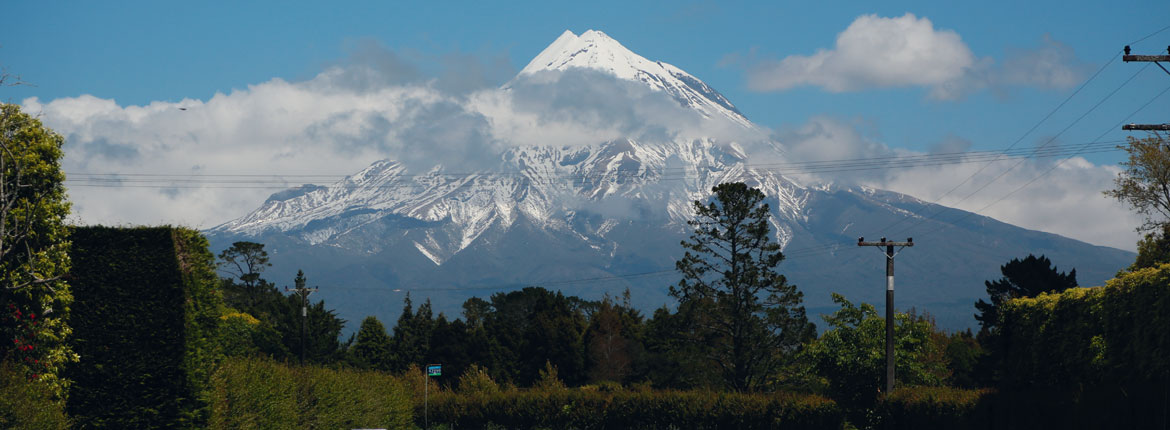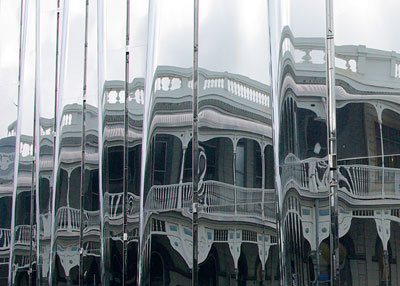
A Weekend Away
The drive from Auckland to Taranaki proves inspiring for Kathryn Webster
The city behind us, a weekend ahead – there is nothing quite like that feeling. By the time we’re done with Auckland’s southern motorway, we’re used to the car we’ve been loaned for this trip. It’s a Lexus RC350 Ltd – a sexy, sporty number that’s perfect for the drive through Waikato countryside, over hilly and winding King Country roads, to Taranaki.
The only problem with the Lexus is that it’s so much fun to drive, we’re reluctant to stop. But we do. We swerve off route slightly to Hamilton Gardens because it’s a favourite. We take a fast, restorative walk along the river and through the flower gardens then visit Molly Macalister’s Little Bull sculpture.
Back on track, we pass watchful Pirongia, zip through classic farming territory, bypass Te Kuiti. At Piopio we stop for a stretch and score some vintage ceramics at a craft shop in the old Post Office.
We get to New Plymouth on dark, but the Devon Hotel is easy to find and we’re soon settled in and walking up to the centre of town on the hunt for dinner. It’s a vibrant town and there’s no shortage of options; we eat Japanese then shoot along the road to where local musicians take turns on stage for an open mic night.
On Saturday morning, we walk around a city corner and yell, both of us: “wow!” Because, like most people coming to New Plymouth these days, we’re visiting the new Len Lye Centre. The wavy stainless steel exterior shimmers and plays; people walk close and back off and look up and laugh at their mangled reflections. It is instantly fun.
Inside, the new museum keeps up the playfulness.
Light dances through tall hidden windows along a sloping ramp. Once in the space where the legendary Len Lye works spring into view, it’s all about that. The focus shifts to fountains of coloured light, waltzing steel, rolling plains of shimmering, haunting shapes. There are masterpieces here – Flip and Two Twisters, Universe – noisy and boisterous; there are quieter works that hypnotise and intrigue. Short films, a genre of art that, along with his kinetic sculpture, Len Lye was internationally famous for, loop in dizzy repeats. It’s an astonishing world and everyone visiting on the day we’re there seems as energised by the experience as we are.
I’m pleased to learn that the exhibitions will change three times each year, to encourage repeat visits. There will also be collaborations with other artists and with musicians, to keep up the energy level of this infectiously happy art.
Next door, the Govett-Brewster Gallery has had a makeover and shines with renewed life.
We step out, back onto the street, and watch the stream of people interacting with the mirrored exterior. It’s a winner, this building. It will attract visitors from far and wide. It’s ironic that its stainless steel evokes thoughts of milk tankers, as tourism is taking over from dairy farming as the main economic driver of regions like Taranaki. We walk over the road for an excellent coffee at Icon café, feeling a bit jealous of this cool community’s genuine respect for culture and creativity.
Holding this mood, we drive south to Oakura Beach and build flimsy sculptures with driftwood, dried seaweed and carefully balanced stones. Then, feeling the need to get close to Mt Taranaki, we drive inland to Stratford, grab some sandwiches and drive uphill to park with a view for an in-car picnic. It’s very cold out. We walk a little, in the snowline, but we’re not equipped, so we keep it short.

On the way back to New Plymouth we stop to photograph the mountain, which is glowing clear and clean against the pink of the evening sky. Initially stark, like a simple silk screen print, the cone becomes more three-dimensional as the light fades.
Leaving New Plymouth early in the day for the drive home gives us time for some breaks in the journey. Not far in, we opt for the first one at Mokau and call into the community museum which is packed with household and farming things: electronic dog collars, photographs, china, toys, tools, everything donated from the 100 kilometres between the tunnels – Mt Messenger to the south and the Awakino Gorge tunnel to the north.
At Awakino we stop to walk the little stretch of baches by the wide river mouth and contemplate taking the track to the coast, but we have to keep moving. We have to get to our final treat of the trip, before it closes.
The rain doesn’t matter a jot. We’re going underground. We’re going into the famously sparkly underworld of Waitomo Caves.
Our tour guide gathers the group together, briefs us and leads us down – talking all the way about the caves’ history and geology. Their magical qualities need no explanation. We stand still in the cathedral in the midst of echoing song. Then we walk on and climb into a boat and float about, silent, on the darkest water imaginable, under the stunning diamond-studded roof and it is like being in a dream.
Do we really have to go back to the big city, with overcrowded rowdiness and lack of open spaces? It was a good thing we had such a nice car to drive the last bit, on the new road that skips Ngaruawahia now, and which carries us over the Bombay Hills toward the orange glow in the northern night sky. It was a good thing that Auckland’s lights sparkled in welcome.
Thanks to Lexus NZ for the use of the car.
Reported by Kathryn Webster
